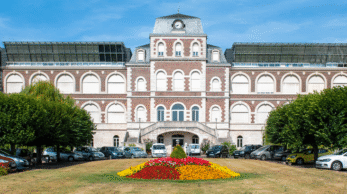Whether public or private, cultural facilities host a significant number of visitors and, therefore, must comply with stringent legal requirements for accessibility and safety. But beyond these traditional challenges, there is also a need to maintain the sites’ appeal and pay special attention to visitor comfort. Consequently, the cultural sector has every reason to implement a rigorous and visitor-oriented preventive maintenance approach.
Diverse Structures with Common Maintenance Goals
The cultural infrastructure sector is characterized by its diversity. Theaters, performance halls, museums, cultural centers, libraries, cinemas, concert venues, and gymnasiums all operate very differently. Each welcomes the public according to its own constraints and requires specific management, often needing to adapt to daily changes.
Nevertheless, cultural sites share a fundamental goal: to offer visitors a high-quality experience at all times. Indeed, the identity of cultural places is significantly influenced by the layout and good condition of assets. Comfort and safety levels must be optimally maintained at all times. For managers, maintaining a cultural site therefore involves:
- Physical preservation of the buildings
- Protection of artworks and/or maintenance of assets for users
- Energy performance
- Creation of welcoming and accessible spaces
- Development of the visitor experience and the site’s identity
Thus, the structure and day-to-day assets – from lighting to air conditioning systems – are just some of the considerations to take into account. To maintain a cultural site holistically, an approach must combine technical expertise and a “user vision.”
Challenges of the Cultural Sector Calling for Maintenance
The COVID-19 pandemic has drastically changed the maintenance context in the cultural sector by introducing new health and operational standards. Professionals must now integrate more complex requirements into their management than before.
Health challenges are at the heart of these new requirements, with indoor air quality being of prime concern. Ventilation and filtration systems must eliminate viral particles and ensure a healthy environment without compromising visitor comfort. Disinfection protocols, once more occasional, have become systematic and rigorous.
Safety issues are also on the rise. Welcoming numerous visitors requires more extensive spaces and sufficient social distancing. In addition, managers must manage sometimes dense visitor flows while limiting their impact on the site experience. From video surveillance to fire safety, many systems must be maintained with utmost precision.
Meanwhile, day-to-day challenges remain the same: the operation of assets and their costs – whether energy or operational – must be controlled throughout the site’s lifespan. Unanticipated equipment renewals can weigh heavily on a manager’s expenses. This is a real challenge for some structures with limited budgets.
The Louvre Museum in Paris is the most telling illustration of these challenges. Faced with complex maintenance problems – water leaks, temperature fluctuations, and general obsolescence of facilities – the venue, which has not undergone major renovations in forty years, is now unsuitable for the volume and demands of modern visitors. The museum had to respond to these new needs urgently, even though preventive maintenance could have eased the site’s growth more serenely.
Better Articulating Cultural Sector Maintenance
Preventive maintenance is now strategic for cultural sites that aim to consistently improve the user experience. More proactive than curative or corrective maintenance, preventive maintenance allows cultural institutions to preserve their heritage despite changes, whether they occur gradually or suddenly.
Indeed, preventive maintenance is based on ongoing data analysis of buildings, allowing anticipation of site needs or even full management in terms of technical, comfort, or environmental impact aspects. Documenting assets and defining standardized maintenance protocols provide a more dynamic framework for interventions and offer managers the flexibility to look further ahead for their assets.
For cultural facilities, this approach has many advantages. It significantly minimizes the impact of maintenance on the visitor experience, preserves asset quality, and helps optimize long-term investments. On a practical level, constant monitoring of asset conditions will allow:
- Real-time understanding of the state of each site and its asset renewal needs
- Acceleration of potential technical audits
- Anticipating and managing operational costs
- Ensuring constant compliance with public building regulations
To implement this maintenance foundation, cultural site managers would be wise to adopt CMMS software, the only guarantee to manage each asset with the best possible level of foresight.
Maintenance Software At the Service of Professionals in the Sector
CMMS (Computerized Maintenance Management System), or maintenance software, is the essential tool for industrial maintenance and its application extends to the management of cultural sites. Regardless of the assets, maintenance software centralizes the essential data needed to maintain a site: a rich and current database that allows for efficient and comprehensive maintenance.
For perfect preventive maintenance, the action of maintenance software is usually coupled with connected sensors. The site thus benefits from real-time monitoring of parameters such as humidity, temperature, vibrations, energy consumption, or component wear. These are all crucial data for the preservation and comfort of cultural sites.
Fed with data, maintenance software not only allows for the analysis of a building’s condition but also its complete lifecycle. This is a significant advantage for cultural sector managers: better-structured information enables the development of a solid maintenance strategy. From detailed asset management to planning interventions, real-time equipment tracking, and collaborative documentation, the vision of the infrastructure becomes more dynamic and adaptable to visitor volumes and changing contexts.
Utilizing these technologies allows public establishments to rigorously address the fundamentals of their maintenance, comply with their budget for sure, but most importantly, focus on the user experience. Thanks to CMMS, asset renewal can be done at a reasoned pace, interventions are planned without disrupting visit quality, and assets remain functional for as long as possible. Maintenance software enables any cultural site to see its systems evolve alongside it. This lightens management and ensures an always optimal visit quality.






